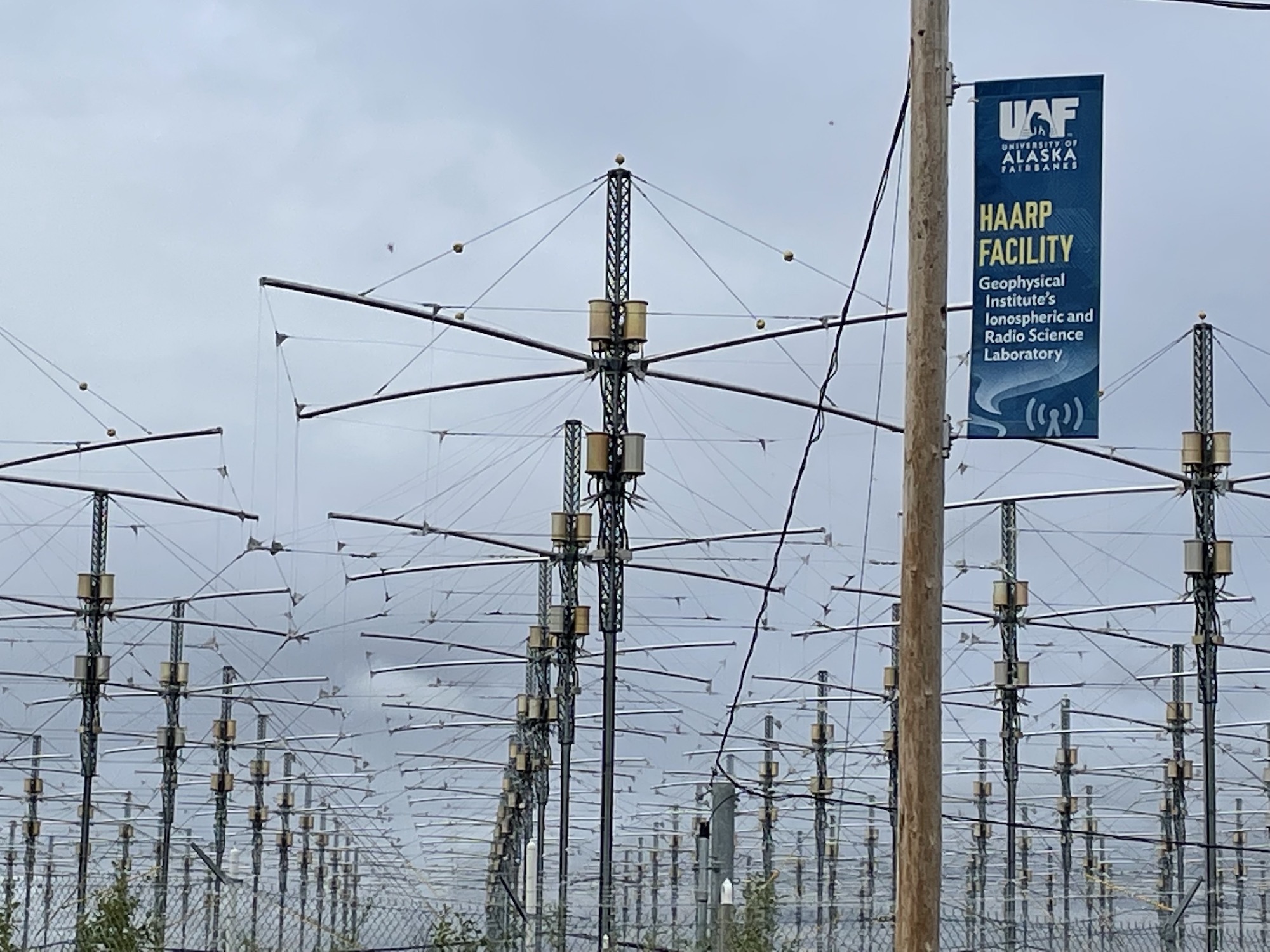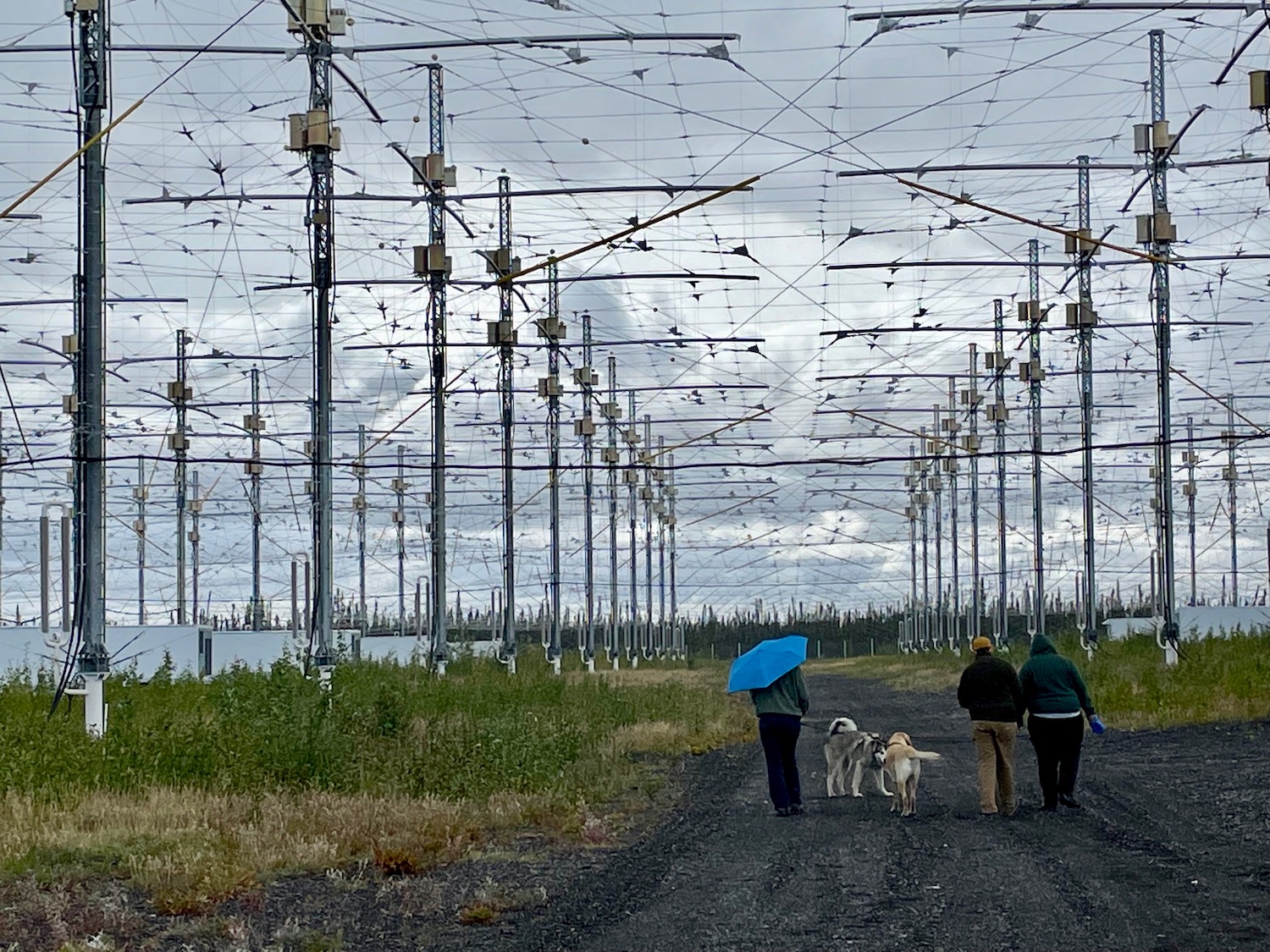An attempt to demystify the mysterious
Ned Rozell
907-474-7468
Sept. 8, 2022

The upper atmosphere-heating facility named HAARP is located on about 5,000 acres between the small Alaska towns of Glennallen and Tok.
NEAR GAKONA, ALASKA — In this wild place where dump truck drivers once tipped load after load of gravel onto the moss to make roads and building pads, scientists rolled open an iron gate one recent Saturday afternoon.
They invited in conspiracy theorists, reality-TV hosts and salmon fishermen from Chistochina to the grounds of a mysterious antenna field. It’s a facility that some claim has caused caribou to walk backward. It has been rumored to activate earthquakes, and to hold human souls in a sort of northern purgatory.
Scientists were a bit to blame for all the allegations of weirdness out here between the Copper and Gakona rivers. First off, they used an acronym to name it — HAARP, which stands for High-frequency Active Auroral Research Program.
That acronym added to the mystery of a field of antennas that can heat a region of space far above our heads with radio waves powered by five powerful diesel generators, each the size of a fuel truck.
The science of studying a region we can’t see by perturbing it with enough electricity to power a small city — located in a place where wolves and bears pad without a sound across its few gravel roads — is hard to wrap your head around.
A few people really understand HAARP, though. They were standing on those smoothed piles of gravel that Saturday when the foreboding metal gate clicked open.
My former boss Sue Mitchell (now retired) initiated this “open house” a few years ago. She was there again in 2022, greeting people at the first table of the first building visitors walked into. I asked her why.
“So we could be as transparent and open as possible,” she said. “Throw open the gate, and show people what’s here.”
When she worked at the Geophysical Institute, Mitchell took the considerable hit of answering phone calls about the HAARP facility. She had no answers for people who were sure the antenna field was somehow controlling their minds.
“My hope has been by showing people what really goes on, the facts will speak for themselves,” she said. “That doesn’t always work. People sometimes make decisions emotionally, not always based on the facts.”
It doesn’t help when the facts are so hard to understand. Here’s a try:
The antenna field at this 5,408-acre site far from any Alaska town was first a chunk of black-spruce forest and wetlands U.S Air Force officials purchased from the Native corporation Ahtna in 1989. The idea was to use the location to build an over-the-horizon radar that would allow technicians to observe bombers or missiles that might be headed for America over the pole.
Due to the end of the Cold War, that radar was never built. Instead, Air Force workers installed a field of 18 antennas that broadcast high-frequency waves up to the ionosphere, the region of space that is home to the aurora.
The antenna field over the years grew to 180, each powered by two transmitters. A researcher has called it the world’s largest ham radio.
HAARP is a group of high-frequency radio transmitters (in the ham-radio band) powered by five diesel generators — four from tugboats and one from a locomotive. When activated, the transmitters send a focused beam of radio-wave energy into the ionosphere, 50-600 miles overhead.
Since it opened in 2003 with funding the late Sen. Ted Stevens helped secure, HAARP has hosted many scientists doing basic science on the auroral zone.

During a recent open house, visitors walk their dogs beneath an antenna field at the HAARP facility.
Others used it to do applied research for the military. In one such study, researchers used the antenna array to heat a part of the ionosphere that in turn acted as a low frequency antenna that could send an ocean-penetrating signal to a submarine. That ping could tell a submarine captain to surface in order to receive conventional radio communications.
This place almost fell to bulldozers in 2012, when the Department of Defense wanted out from under the cost of running the facility (which includes about $250,000 each year just to heat the dozens of transmitter buildings in the winter).
About then, Bob McCoy, the director of the Geophysical Institute and a space physicist himself, lobbied for the institute to take over the site. Scientists rallied around him, as did the university president at the time.
At the same time, leaders of the National Research Council held a workshop about HAARP. They wrote a 70-page report on science that could be accomplished with the facility.
“Even though it's esoteric and hard to understand, it's the best,” McCoy said in 2015.
The university administration gave McCoy a loan to keep HAARP running. He gambled that he could pay it back by drumming up business from scientists. They would use the transmitters and pay for it with grants from funding agencies. That gamble is paying off, with a new 5-year grant from the National Science Foundation.

Geophysical Institute Director Bob McCoy poses with visitor Michael Lewis from Anchorage during a recent open house at the HAARP facility.
McCoy was there at the entrance to HAARP that Saturday, answering questions from people like Michael Lewis of Anchorage.
Lewis, who wore a baseball hat he had covered with tin foil (apparently for fun), said he had always wanted to see the facility. McCoy posed for a photo with him.
Visitors were allowed all over the grounds of the facility during the open house. Swampy ground limited them to drive and walk the few miles of road and gravel pad, including the dormant transmitter array.
Scientists and engineers were stationed at strategic points to explain what the complicated equipment did when it was on. A few guests were ham-radio enthusiasts, but most seemed to be just curious people.
After the five-hour open house ended, the black gate shut behind the final car. Then, HAARP reverted to what it is most of the year: a silent pile of gravel sprouting with antennae. There, songbirds on their way south flitted through the spruce and on the ground beneath the antenna masts.
Since the late 1970s, the University of Alaska Fairbanks Geophysical Institute has provided this column free in cooperation with the UAF research community. Ned Rozell is a science writer for the Geophysical Institute.


